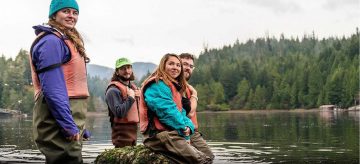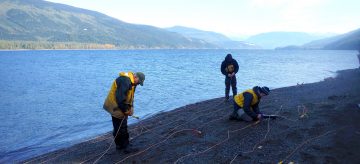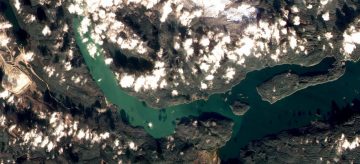Overview
Although Canada has more water than most nations, fluctuations in the quantity and quality of our available water, due to climate change and other human influences, greatly affect Canadian life. Most water quality issues require an understanding of physical processes such as circulation and irreversible mixing.
Examples include trapping of nutrients behind upstream reservoirs, nutrient supply to the photic zone supporting phytoplankton and fisheries food supply, effluent dispersal in lakes and coastal waters, and the path of contaminants (such as E. coli and Cryptosporidium) to drinking water supply intakes and beaches.
Environmental Fluid Mechanics focuses on the description and understanding of the physical dynamics of water bodies with the aim of developing numerical models for the prediction of the impacts of climate change and human activities on lake circulation.
Key Areas
- Physical problems of contaminant transport
- Stratified flows
- Mixing
- Turbulence and ice-water interactions
Media Highlights
- A Q&A with UBC Civil Research Assistant on the Aftermath of Mount Polley Spill
- UBC Environmental Engineering receives Board accreditation
- Mount Polley mine tailings in Quesnel Lake eight years after spill
- Years after Mount Polley disaster, study reveals ongoing problems
Specialization Requirements
| MASc | PhD | |
|---|---|---|
| Elective courses (min. credits) | 17 | 29 |
| Seminar course | CIVL 597-102/202 | CIVL 597-102/202 |
| Thesis course | CIVL 599 | CIVL 699 |
Elective requirements
Electives may be taken from the list of Approved Electives below, or other electives may be taken with the approval of the Specialty Advisor / Supervisor.
Undergraduate students who are interested in Environmental Fluid Mechanics are directed to the following courses:
- CIVL 416
- CIVL 417
Graduate Courses
Electives may be taken from the List of Approved Electives below, or other courses may be taken with the approval of the Supervisor.
| Approved Elective Courses | Name | Credits | Term |
| 1CIVL 540 | Advanced Coastal Engineering | 3 | 2 |
| 2CIVL 541 | Environmental Fluid Mechanics | 3 | N/A |
| 2CIVL 542 | Physical Limnology | 3 | N/A |
| 2CIVL 543 | Turbulent Fluid Dynamics | 3 | N/A |
| 2CIVL 547 | Estuary Hydraulics | 2 | N/A |
| CIVL 558 | Water Resources Infrastructure | 2 | 2 |
| CIVL 566 | Transport and Mixing of Pollutants in Aquatic Systems | 3 | 2 |
| CIVL 569 | Biological Waste Water Treatment | 3 | 1 |
| EOSC 512 | Advanced Geophysical Fluid Dynamics | 3 | 1 |
| EOSC 571C | Intro to Res in Atmos. Sci. & Physical Limnology | 3 | N/A |
| MECH 586 | Turbulent Shear Flow | 3 | 2 |
| Approved Undergraduate Electives | Name | Credits | Term |
| CIVL 407 | Environmental Laboratory Analysis | 3 | N/A |
| 2CIVL 416 | Environmental Hydraulics | 3 | 1 |
| CIVL 418 | Engineering Hydrology | 3 | 2 |
| BIOL 402 | Aquatic Ecology | 3 | 1 |
| EOSC 474 | Marine Pollution | 3 | 1 |
| MATH 400 | Applied Partial Differential Equations | 3 | 1 or 2 |
1Credit will only be granted for one of CIVL 417 / 540.
2These are considered the highest priority courses and should be taken if available
Questions?
To learn more about Environmental Fluid Mechanics at UBC, contact Dr. Greg Lawrence.
People
Facilities
Specialized facilities for studies in Environmental Fluid Mechanics include recirculating sediment flumes, fresh water flumes, stratified flow facilities, laser doppler anemometer, and acoustic doppler velocimeter. Learn more.






